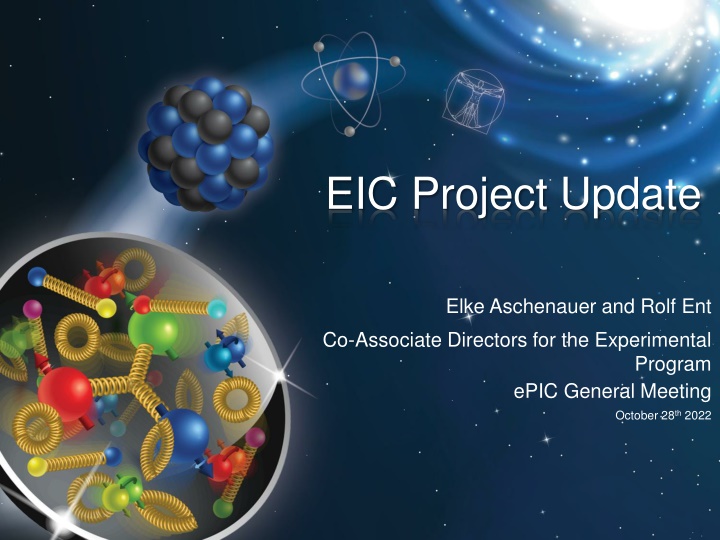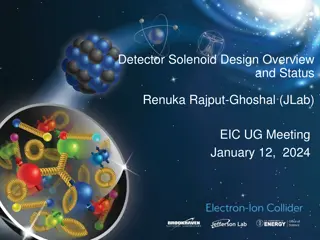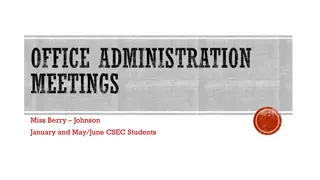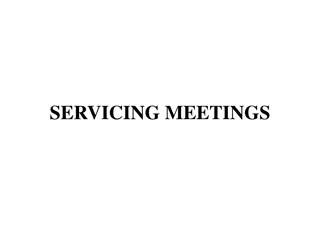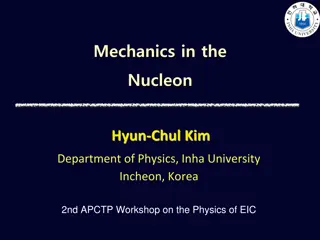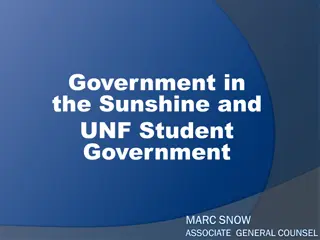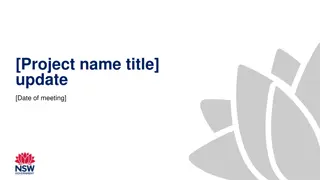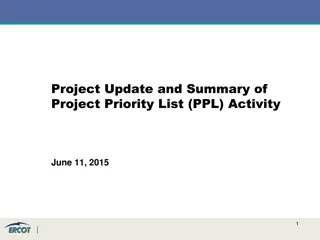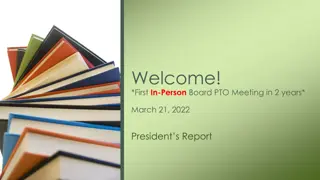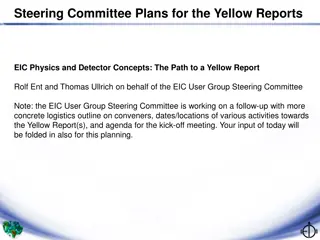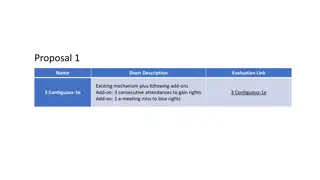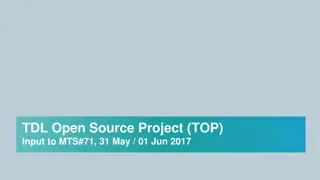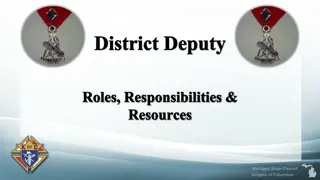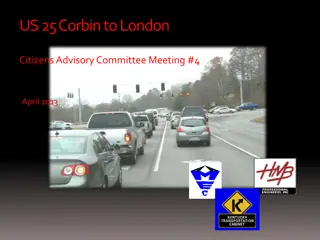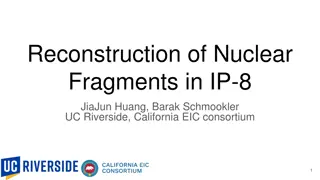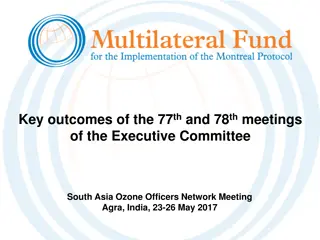Update on Recent Events and Meetings at the EIC Project
Highlights include the appointment of Elke Aschenauer and Rolf Ent as Co-Associate Directors for the Experimental Program, discussions and preparations for upcoming meetings such as the Resource Review Board kickoff and the Detector Advisory Committee, as well as key updates on project progress and collaboration efforts. The Role of the Resource Review Board in overseeing project coordination and funding aspects is also outlined.
Download Presentation

Please find below an Image/Link to download the presentation.
The content on the website is provided AS IS for your information and personal use only. It may not be sold, licensed, or shared on other websites without obtaining consent from the author.If you encounter any issues during the download, it is possible that the publisher has removed the file from their server.
You are allowed to download the files provided on this website for personal or commercial use, subject to the condition that they are used lawfully. All files are the property of their respective owners.
The content on the website is provided AS IS for your information and personal use only. It may not be sold, licensed, or shared on other websites without obtaining consent from the author.
E N D
Presentation Transcript
EIC Project Update Elke Aschenauer and Rolf Ent Co-Associate Directors for the Experimental Program ePIC General Meeting October 28th2022
Recent Events September 26 EIC Advisory Board meeting (~ Director s Council for US projects) October 12-13 Resource Review Board -like kickoff meeting https://indico.bnl.gov/event/17354/ Now planning for first RRB meeting April 2023 October 18-19 60% Magnet Review @ JLab We implemented the design change to go to six layers of conductor with thanks to our CEA Saclay colleagues to help us out. This should allow a robust 1.7 Tesla magnet with stretch goal of 2 T. Five engineers from CEA Saclay attended in person. The meeting will be hybrid as the reviewers and further engineers/designers will be remote. The reviewers will be the same as for the earlier 30% design review and are confirmed Ruben Fair (PPPL) chair, Vladimir Kashikhin (FNAL), GianLuca Sabbi (LBNL). October 19-21 Detector Advisory Committee meeting EIC project update Update on the EPIC detector, the steps following the DPAP process and as main part of the meeting reports on the status of the various project detector R&D projects and FY23 plans/requests https://indico.bnl.gov/event/17159/ 2
Pre-RRB Meeting Agenda Participation from Canada, Czech, France, Italy, Japan, Korea, Poland, UK 3
Discussion on Action Items and Adjusted RRB Model David Dean, Haiyan Gao, Rolf Ent (with input from Elke Aschenauer, Maria Chamizo-LLatas, Luisella Lari, Jim Yeck) EIC Pre-RRB Meeting October 13th 2022 Electron Ion Collider
Role of RRB for experiment and computing 10/13/2022 adjusted after discussion Provide coordination among the different funding partners during the two phases Construction of the experiment Operation and scientific exploitation Oversight of the experiments and computing Reaching agreement on contributions to the experiments and computing Monitoring progress, finances and workforce support Reaching agreement on common projects and the use of common funds (when proposed and supported) Reaching agreement on maintenance and operations scope and financing and monitoring its functioning Endorsing the annual construction and maintenance and operations budgets of the detector The RRB is not a scientific committee. The RRB is about making sure the plans for the experiments are consistent with the resources reasonably expected to be available. 5
. Homework and First RRB meeting EIC Project and host labs: define expectations up front on how new members can come in, and how to make decisions Non-DOE funding agencies to decide on election/rotation scheme for RRB co-chair Initial RRB to draft charter as first organizational step? Aim for the first RRB meeting in Spring 2023 Discuss level* of documents and agreements towards CD- 2/3A * ECA/RE: means projected state of completion 6
Recent Events September 26 EIC Advisory Board meeting October 12-13 Resource Review Board -like kickoff meeting Now planning for first RRB meeting April 2023 October 18-19 60% Magnet Review @ JLab We implemented the design change to go to six layers of conductor with thanks to our CEA Saclay colleagues to help us out. This should allow a robust 1.7 Tesla magnet with stretch goal of 2 T. Five engineers from CEA Saclay attended in person. The meeting will be hybrid as the reviewers and further engineers/designers will be remote. The reviewers will be the same as for the earlier 30% design review and are confirmed Ruben Fair (PPPL) chair, Vladimir Kashikhin (FNAL), GianLuca Sabbi (LBNL). October 19-21 Detector Advisory Committee meeting EIC project update Update on the EPIC detector, the steps following the DPAP process and as main part of the meeting reports on the status of the various project detector R&D projects and FY23 plans/requests https://indico.bnl.gov/event/17159/ 7
Context EIC MARCO Magnet Design Change ~ August can we make a conservative magnet design that can reach a robust >1.5 Tesla but with the BaBar magnet geometry? possible concerns: increase of technical risk, increase of material need (nuclear interaction lengths) and increase in costs. High-level summary of first view: Increase number of conductor layers from 4 to 6 this is possible within the geometry and given the present conductor choice Actually, this has a plus in that the current requirement goes down to 4000 Amps which increase critical current margin a magnet high-level design parameter. The temperature margin remains very safe. The nuclear interaction lengths for the BaBar magnet is 0.36, for the initial 1.5 Tesla new magnet design it was 0.42, it became 0.36 once CEA-Saclay had finalized the conductor choice, and now for a potential 2 Tesla new magnet it is back to 0.42 again this is acceptable The stored power goes like field squared, so from 1.5 Tesla to 2 Tesla it goes up by a factor of 1.78. Cost goes roughly as stored power to the power 0.7, so cost would go up a factor of 1.5. That roughly equates to +5M$. This was accepted by the EIC Management Team as needed for the EIC science and is now included as part of the P6 baseline cost/schedule. 8
Additional Info on Use of BaBAR Magnet Use of BaBAR magnet is in the risk registry as an opportunity, currently at 10% The probability to use the BaBAR magnet is shrinking This is because the design of the ePIC detector is very different from the symmetric-collider cases of sPHENIX / BaBAR. This affects the material distribution and as a result the internal forces the forces on the magnet increase BaBAR magnet can only reach 1.15 T for the sPHENIX operating current one would have to increase the current to reach 1.5 T this requires invasive repairs of diagnostics and safety systems increased risk the science requirement for tracking is larger than 1.5 T 1.7 T 60% design review recommendation to drop the BaBAR magnet option 9 E.C. Aschenauer
Closeout Report Ruben Fair; Gianluca Sabbi; and Vladimir Kashikhin 60% Solenoid Magnet Subsystem Technical Design Review October 18-19, 2022
Conclusion 1. Significant progress has been made since the 30% design review point in Feb 2022. However, a change to the magnet field requirements and the conductor design approach (i.e. utilizing Cu-clad instead of Al-clad) has meant that some work has had to be repeated, and as a result other work required for the 60% design point has perhaps lagged somewhat. 2. The formalization of the requirements and interface documents is still a work in progress and further changes at this stage in the design process could pose a risk to schedule and cost. 3. The collaboration between Jlab, CEA-Saclay and BNL is working very well. 4. The current JLab/CEA-Saclay team will be on track to be ready for the 90% design review in 2023 as long as the recommendations are addressed adequately.
New Recommendations 1. By end Dec 2022, reassess the use of the BABAR magnet as an opportunity, now that the team has a better understanding of the requirements and any shortcomings of the BABAR magnet in achieving those requirements. Given the field requirement of 1.7 T to 2.0 T, we recommend dropping the BABAR magnet option. 2. By end Feb 2023, approve the magnet requirements document formally, and utilize a change control process for any further changes to requirements. 3. By Mar 2023, fast-track the design aspects of the magnet that presently appear to be at a lower maturity level than the 60% design point. 4. By Sep 2023, complete and approve the interface document. Utilize a change control process for any further changes to interfaces. 5. By Sep 2023, include ESH&Q considerations in the magnet and system design. 6. By the CD2/3A review date, demonstrate significant progress in prototyping and characterization of sample conductor and plans for full conductor production.
Recent Events September 26 EIC Advisory Board meeting October 12-13 Resource Review Board -like kickoff meeting Now planning for first RRB meeting April 2023 October 18-19 60% Magnet Review @ JLab We implemented the design change to go to six layers of conductor with thanks to our CEA Saclay colleagues to help us out. This should allow a robust 1.7 Tesla magnet with stretch goal of 2 T. Five engineers from CEA Saclay attended in person. The meeting will be hybrid as the reviewers and further engineers/designers will be remote. The reviewers will be the same as for the earlier 30% design review and are confirmed Ruben Fair (PPPL) chair, Vladimir Kashikhin (FNAL), GianLuca Sabbi (LBNL). October 19-21 Detector Advisory Committee meeting EIC project update Update on the EPIC detector, the steps following the DPAP process and as main part of the meeting reports on the status of the various project detector R&D projects and FY23 plans/requests https://indico.bnl.gov/event/17159/ 13
Context Project Detector R&D Proposals Most proposals were submitted by October 1st, all proposals were submitted by October 3rd (compilation of ASICs/electronics proposals took extra time). See https://wiki.bnl.gov/conferences/index.php/ProjectRandDFY23 Main surprise: large increase in Si-related detector R&D requests, we worked with the Si consortium to understand this. The Si consortium subsequently submitted revised proposals (thanks!). DAC Meeting October 19-21: https://indico.bnl.gov/event/17159/ Good presence of the DAC: 9 were present all days or most of it. We also discussed the charter with the DAC and after their initial tenure we start the process to rotate each year 4 members (out of 12) off, starting late this year. New members get a 3-year tenure. 14
Upcoming: meetings of Patrizia, Thomas, Elke, Rolf to go over the various DAC R&D-specific recommendations. Largest issue is how to fit in a box (mainly due to that Si MAPS-ITS3 sensors moved to project R&D) 17
Upcoming Events October-December EIC Subsystem Status Reviews on Tracking, Particle Identification Systems, Electromagnetic Calorimetry, Hadronic Calorimetry, Infrastructure/Installation, Polarimetry already completed Magnet Incremental Design and Safety Review (6.10.07) Preliminary 30% Design IR Integration and Ancillary detectors (6.10.11) Electronics/Computing Subsystem Status Review (6.10.08 & 6.10.09) Magnet Incremental Design and Safety Review (6.10.07) 60% Design in planning stage Calorimetry Review (6.10.05 & 6.10.06) First two weeks December Polarimetry Review (6.10.14) Aim before end of CY Incremental Integration/Installation Review waiting for sPHENIX installation schedule To do beyond Tracking Review (6.10.03) Particle Identification Review (6.10.04) Infrastructure Review (6.10.10) Magnet Incremental Design and Safety Review (6.10.07) 90% Design ~September 2023 DOE OPA Status Review - Confirm CD-2/3A Plans Preliminary Design and Director s Reviews DOE CD 2/3A OPA Review and ICR, requires pre-TDR DOE CD 2/3A ESAAB Approval Jan. 31 Feb. 2, 2023 June 2023 October 2023 January 2024 18
Incremental Design and Safety Review of the EIC Detector Calorimeters Timing: 2 days, period of November 28 to December 14 (preferentially November 28 - December 9). Assume each day from 8 am to 2 pm EST, or 2 pm to 8 pm CET. DRAFT!!!! Agenda Day-one (note that each talk time assumes more than 1/3 of time for questions and discussion) 30 min Executive Session (Closed Session) needs some time as context important 30 min Welcome and Introduction (introduce the general project status) Elke/Rolf 30 min Electromagnetic Calorimetry Overview and Requirements Sasha Bazilevsky (BNL) 30 min Hadronic Calorimetry Overview and Requirements Alexander Kiselev (BNL) 30 min Overall Detector Integration Status and CAD Design Roland Wimmer or Rahul Sharma (BNL) 30 min Break 40 min Backward Electromagnetic Calorimetry detector and integration 20 min Backward Hadron Calorimetry detector upgrade (material distribution and impact on magnet design, backward HCal requirements, simulations and feasibility 40 min SciGlass-Based Barrel Electromagnetic Calorimetry detector and integration 20 min Imaging-Calorimeter Barrel Electromagnetic Calorimetry alternate option TBD (ANL) 60 min Executive Session Discussion Carlos Munoz Camacho (IJCLab) and engineer Leszek Kosarzewski (CTU Prague) Tanja Horn (CUA) and Josh/Avishay Agenda Day-Two 30 min 40 min 40 min 20 min 20 min 30 min 3 hr Barrel Hadronic Calorimetry detector and upgrades John Lajoie (ISU) Forward Electromagnetic Calorimetry detector and integration Oleg Tsai (UCLA) and engineer Forward Hadronic Calorimetry detector and integration Friederike Bock (ORNL) and engineer Calorimetry Electronics Overview Fernando Barbosa (JLab) Forward Hadronic Calorimetry electronics Gerard Visser (Indiana) Break Executive Session and closeout 19
International Engagement Many international engagement meetings are planned both from the labs/project side and from the DOE/NP side, with individual agencies. 08/23/2022: meeting of DOE and UK/STFC representatives, EIC large topic Feedback from DOE/NP: very positive meeting 08/31/2022: meeting of DOE and France/IN2P3 representatives, topic mainly FRIB but also EIC Feedback from DOE/NP on EIC: strong support by IN2P3 for groups there and detector, end of October official presentation of EIC/IN2P3 group to IN2P3 council. 09/12/2022: meeting of DOE and Israel/BSF representatives at BNL Feedback from DOE/NP: positive, want to sign contract (similar as NSF-Israel) 10/12-13/2022: pre-RRB kickoff meeting, agencies and country PIs https://indico.bnl.gov/event/17354/ International Attendance: UK, Korea, Czech, Canada, Japan, Poland, Italy Tim Hallman: DOE would be just another seat at the RRB table Discussion of DOE meeting with ICT Korea/Ministry of Science late October? DOE/NP setting up meeting with various international agencies (6-10?) in Washington DC tentatively scheduled for November 17. 20 E.C. Aschenauer
